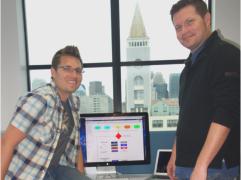Gliffy: bootstrapped in San Francisco

It's rumored that a Web entrepreneur only has to walk down the street in downtown San Francisco to attract VC funding these days. That's probably an exaggeration, but even so, you can't help but admire the grit of Gliffy's co-founders, Chris Kohlhardt and Clint Dickson (pictured in their new office, below). They've chosen to bootstrap their San Francisco-based start-up to the point where, seven years later [update: not five as I originally wrote] and with a user base of millions, they're now completing a port to HTML5 and contemplating the next phase of expansion — all without a penny of outside financing. And business is good:

"We are pretty darn profitable right now. Our growth is not constrained right now because of lack of finances," CEO Kohlhardt told me in a phone conversation last week. And he has no regrets about their chosen path: "We are able to focus on what we're passionate about rather than what VCs and investors think we ought to be doing ... Our goal is not to make some investor 10x their money back. Our goal is to build products that we love."
The company's product is a browser-based tool for creating diagrams and charts. Available both as a cloud application and as a downloadable plug-in for Australian software maker Atlassian's Confluence documentation wiki, Gliffy is a popular and less costly alternative to Microsoft Visio. It is mostly used in planning and documenting software development, business processes and organisation charts, with an emphasis on functional business graphics such as diagrams, flowcharts and wireframes.
"The types of people using our product are not just software developers. They're more trying to explain to developers what they want built," Kohlhardt explained. That emphasis on expressing ideas visually is likely to guide Gliffy's product evolution over the coming year, he added. "I'm really interested in taking the product beyond what Visio offers and help people really visualize what's in their head."
For the past year, the focus has been on a major port from Adobe Flash — which had been the only viable option back in 2006 for a browser-based drag-and-drop graphics tool — to become a native HTML5 application. Gliffy claims the result is one of the most sophisticated business applications now available on HTML5. While that effort has put development of all-new features on hold, it now paves the way for rapidly introducing mobile and tablet versions and has had other notable effects. The new version runs twice as fast, for example, and developers can be more productive because there's no need to compile to see the results of their work, as had been the case with Flash.
With the move to HTML5, it's also proven far easier to hire people, said Kohlhardt. "Developers have hated Flash for a long time for lots of different reasons. That was always a painful thing in terms of trying to hire people and get poeple excited about our product. Once we started talking about wanting to move onto HTML5 that changed a lot of things."
The finished HTML5 code was released last month for the Confluence plug-in and will come to the cloud version early next year. The Flash version remains available for customers with older browsers, such as IE8, which don't support HTML5.
The Confluence version came first because it represents a key part of Gliffy's customer base. An early tie-up with Atlassian was instrumental in Gliffy's success as a venture. At the beginning, "We weren't really interested in selling, we weren't really interested in raising money," said Kohlhardt. "The first thing to do was to get the product out there." After pitching the tool as an add-on to wiki makers such as JotSpot (which soon after became Google Sites), the idea came up to approach Atlassian.
The founders emailed Atlassian's generic 'info@' email address and got a reply from co-founder Mike Cannon-Brookes, saying that he happened to be in San Francisco at the time. With his help the team integrated Gliffy with Confluence and soon started growing a healthy revenue stream, which has since been supplemented by online sales of the cloud app.
So although being in San Francisco hasn't led to venture funding, it was instrumental in making the connection that secured Gliffy's future. Perhaps those streets really are paved with gold, after all.